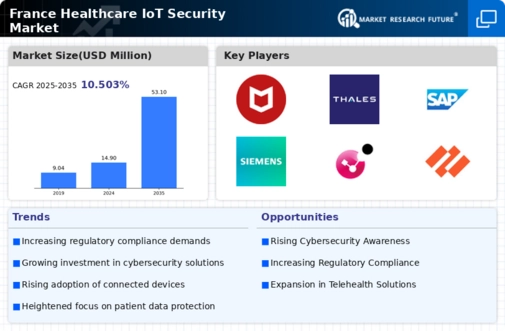Rising Cybersecurity Threats
The escalating frequency and sophistication of cyberattacks targeting healthcare organizations in France significantly influence the healthcare iot-security market. Recent reports indicate that over 30% of healthcare institutions have experienced a cyber incident in the past year, underscoring the vulnerability of connected medical devices. As cybercriminals increasingly exploit weaknesses in IoT systems, healthcare providers are compelled to enhance their security frameworks. This trend is expected to drive investments in cybersecurity solutions, including threat detection and response systems, thereby propelling the growth of the healthcare iot-security market. The urgency to protect patient data and maintain operational integrity is likely to remain a critical focus for healthcare organizations.
Collaboration Among Stakeholders
The growing collaboration among various stakeholders in the healthcare sector is driving the healthcare IoT-Security market. Partnerships between healthcare providers, technology vendors, and regulatory bodies are becoming increasingly common as organizations recognize the need for a unified approach to security. In 2025, it is anticipated that collaborative initiatives will lead to a 20% increase in the implementation of standardized security protocols across healthcare facilities in France. This collective effort aims to address the diverse security challenges posed by IoT devices, ensuring a more secure environment for patient data. As stakeholders work together to enhance security measures, the healthcare iot-security market is likely to benefit from increased investment and innovation.
Increased Focus on Patient Privacy
The heightened emphasis on patient privacy in France is a significant driver for the healthcare iot-security market. With the implementation of stringent data protection laws, healthcare providers are under pressure to ensure the confidentiality and integrity of patient information. In 2025, it is projected that compliance costs related to data protection will account for approximately 15% of healthcare IT budgets. This financial commitment reflects the necessity for advanced security measures to protect sensitive data transmitted through IoT devices. As healthcare organizations strive to meet regulatory requirements and build patient trust, investments in security solutions are likely to surge, thereby fostering growth in the healthcare iot-security market.
Growing Demand for Connected Medical Devices
The increasing adoption of connected medical devices in France is a primary driver for the healthcare IoT-Security market. As hospitals and clinics integrate more IoT-enabled devices, the need for robust security measures becomes paramount. In 2025, it is estimated that the number of connected medical devices in France will exceed 10 million, highlighting the urgency for effective security solutions. This surge in connected devices raises concerns about data breaches and unauthorized access, prompting healthcare organizations to invest in advanced security protocols. Consequently, the healthcare iot-security market is likely to experience substantial growth as stakeholders prioritize safeguarding sensitive patient information and ensuring compliance with data protection regulations.
Technological Advancements in Security Solutions
The rapid evolution of security technologies is a crucial driver for the healthcare iot-security market. Innovations such as artificial intelligence and machine learning are being integrated into security frameworks, enhancing the ability to detect and respond to threats in real-time. In France, the adoption of these advanced technologies is expected to increase by 25% over the next few years, as healthcare organizations seek to bolster their defenses against cyber threats. This technological shift not only improves the effectiveness of security measures but also reduces the overall risk associated with connected medical devices. Consequently, the healthcare iot-security market is poised for growth as organizations leverage these advancements to protect patient data.

























Leave a Comment